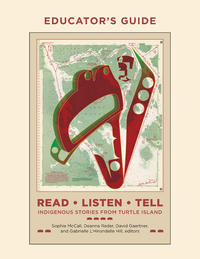This curriculum document was created to supplement the text Read, Listen, Tell: Indigenous Stories from Turtle Island (Waterloo, ON: Wilfrid Laurier University Press, 2017), edited by Sophie McCall, Deanna Reder, David Gaertner, and Gabrielle L’Hirondelle Hill. For each chapter of the book, a series of lessons appears. The curriculum is set up in such a way that you do not need to follow the order of the chapters. You can follow the flow and the energy of the class and go in the direction that the students need or want.
"It demands that you ... think carefully about the complex relationships between writing and reading, storytelling and image-making—relationships at the heart of stories and the interpretive approaches in Read, Listen, Tell."
Download the Educator Guide PDF here
We have attempted to keep this quotation in mind throughout the writing of this entire curriculum. The lessons give students and teachers a chance to build relationships with the stories in the book, with each other, and most importantly with themselves. At the end of each lesson is a teacher’s reflection piece in which a teacher engages with the text and the assignments from a student perspective. Both teacher and student Read a story, Listen to their own and others’ thoughts on the story, and Tell their own story and its connection to the stories of others. We created this document with Grade 11 Contemporary Aboriginal Voices (NBE3U) and the Grade 11 English (ENG3U) in mind. The four strands for Contemporary Aboriginal Voices are: Identity (Who am I?), Relationships (exploring personal connections that Indigenous peoples have made spiritually and culturally with their world), Sovereignty (the spiritual understanding that the Creator gives human beings responsibility for governing themselves and taking care of the natural environment), and Challenges (challenges in Canadian life right now is the need to reclaim, reassert, and further develop distinct identities, relationships, and sovereignty). These four strands are in direct alignment with the chapters from Read, Listen, Tell. The lesson plans work with each strand and the culminating activity gives students a chance to bring all of the strands together for their final piece of work. The culminating activity, which appears below, is to be given out at the beginning of the course in order to make students aware of the direction the course will be taking.
POSSIBLE TEACHING STRATEGIES FOR INDIGENIZING THE CLASSROOM
Circles represent important principles in many Indigenous world views and belief systems – namely, interconnectedness, equality, and continuity. According to traditional teaching, the seasonal pattern of life and renewal and the movement of animals and people were continuous, like a circle, which has no beginning and no end. Circles suggest inclusiveness and the lack of a hierarchy. They are found throughout nature – for instance, in the movement of the seasons and the sun’s movement from east to west during the day. Circles are used in the construction of teepees and sweat lodges. The circular willow hoop, medicine wheel, and dream catcher are powerful symbols.
NOTE: Throughout this curriculum we ask teachers and students to be mindful and honour the symbols and cultures explored in order to avoid Indigenous appropriation. Appropriation refers to using Indigenous symbols or cultural practices in a way that may cause emotional, spiritual, or cultural harm. It is therefore important to know and understand the stories in order to honour and show respect.
CURRICULUM LINK TO THE TRUTH AND RECONCILIATION COMMISSION (TRC) CALLS TO ACTION
By critically exploring the Calls to Action of the Truth and Reconciliation Commission and listening to the perspectives of Indigenous peoples, readers will be able to deepen their understanding of current Turtle Island Indigenous perspectives today in order to be responsive to all learners, particularly those who are First Nations, Métis, or Inuit. This document relates directly to the Truth and Reconciliation Calls to Action (TRC) for Education 62 and 63: Education for Reconciliation
62. We call upon the federal, provincial, and territorial governments, in consultation and collaboration with Survivors, Aboriginal peoples, and educators, to:
i. Make age-appropriate curriculum on residential schools, Treaties, and Aboriginal peoples’ historical and contemporary contributions to Canada a mandatory education requirement for Kindergarten to Grade 12 students.
ii. Provide the necessary funding to post-secondary institutions to educate teachers on how to integrate Indigenous knowledge and teaching methods into classrooms.
iii. Provide the necessary funding to Aboriginal schools to utilize Indigenous knowledge and teaching methods in classrooms.
iv. Establish senior-level positions in government at the assistant deputy minister level or higher dedicated to Aboriginal content in education.
63. We call upon the Council of Ministers of Education, Canada, to maintain an annual commitment to Aboriginal education issues, including:
i. Developing and implementing Kindergarten to Grade 12 curriculum and learning resources on Aboriginal peoples in Canadian history and the history and legacy of residential schools.
ii. Sharing information and best practices on teaching curriculum related to residential schools and Aboriginal history.
iii. Building student capacity for intercultural understanding, empathy, and mutual respect.
iv. Identifying teacher-training needs relating to the above.


